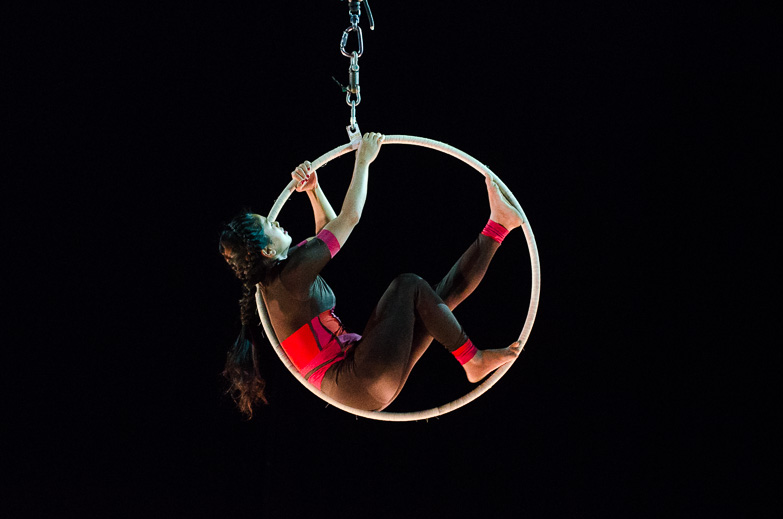Glastonbury Festival; 28th June 2014

After a year and a day, the long-awaited UK debut of Circus Kathmandu was a triumphant success at the Glastonbury Festival Circus Tent. Refused entry visa’s to the UK despite being booked last year, yesterday’s first night was postponed due to storm warnings at the festival. The warm atmosphere amongst the crowd tonight, however, is indicative not only of an interest in the company’s long journey as survivors of human trafficking, but also of the high quality performances on offer.
‘Swagatam‘ means ‘welcome’, and the show tonight is an edited version of the full height aerial production (they also have street and theatre incarnations). The house compère reminds us that the show has developed from autobiographical stories that the artists want to share, and it is easy to read our own narratives into the scenes they bring to life. Dressed in feisty oranges, reds and blacks, the Nepali acrobats’ singing slowly rises above the soul music booming in from outside the tent, while the ensemble rhythmically beat and sweep the stage with reed brooms. Emerging out of an angrily shouted exchange, Bijaya L discovers a new use for his broom as a juggling club, and others soon join him with their own 3-club toss. Joyful flips and springs fill the stage, and then, to the sounds of pipes and drums, the company members slowly approach the audience, placing flowers, as if on graves.
While Jamuni executes a sequence of poses on the vertical rope, the rest of the troupe perform a sort of ensemble yoga. I think of a rigid training, and seemingly unattainable long-dreamt of freedoms.
From a bustling crowd, Aman is revealed alone centre stage, trying to break free from his aerial straps as if they are restraints. Lifted up into the air, he is left hanging, while Bijay C soundlessly tumbles across the stage, attempting to remove the ties around his wrists. He finds himself at the straps, releases Aman and takes to the air himself, as if in exploration of his bonds. His rolls up and down the straps are like silk – as though the strength he possesses had come at no cost – and his swift somersaulting dismount comes as a sharp shock.
A babble of talk in language I don’t understand echoes the experiences of being sold into foreign lands. Hectic business co-exists with confusion and isolation, and Bijaya L’s chair balancing becomes a built prison. Amongst many members of the troupe is the inbuilt will to pose for applause after each trick, as they would have in their initial circus slavery in India. Here, it may be breaking out of their symbolic world, but is endearing in the real one. I know how gruelling circus training is, and the thought that anyone should be forced into it is sickening.

Renu contorts around an aerial hoop to the sounds of a piano, evoking peace and a hope for playfulness. The colours of her costume and white hoop against the black back curtain make an arresting image of yins and yangs.
A Chinese pole is set to what strikes me as Bollywood dancing – although I will admit to a limited understanding of Asian cultures. A 3-pronged base, rather than tethers, gives a much wobblier structure than I’m used to seeing, and I must commend Rajan for his dynamism on such an unsteady pole, which also allows for a very nice drop from a one-handed hang off the top.
Bijay C swings an telling set of meteors that remind me of an upbringing far from my own UK comforts, and an upbeat beauty pageant shows another life again. A well synchronised aerial silks number from Renu, Sittal and Bijay C plays out to oriental music that still holds a spiritual fascination for many Westerners, and they are joined by Lalita in an elegant doubles routine.
Renu’s serene contortion heralds an all-girl take-over of the stage, building human pyramids and other structures as the men emerge to admire and flirt; I’m not entirely sure whether it’s good natured, and they give a faintly oppressive air. The petite Sarmila is tossed from a banquine, and now the men take over in friendly competitive macho games of acrobatics. A crowd-pleasing human tower deconstructs for Anjali and Sarswati to launch into a joyful hula-hoop dance, while intimate familial groups appear upstage. As Sarswati catches 20 of the shining hoops, we end with a real party spirit.
The tent erupts into a standing ovation – only the fourth in the history of the Glastonbury big top – and the smiling artists retrieve the flowers placed around the edges of the stage, and retreat. If these are their stories, they carry them away with them, close to their hearts. As we will carry the images they’ve left us.

Creative Producer and Original concept: Ali Williams
Direction: Paul Evans and Sverre Waage
Design: Sean Donohoe, Loz Buzzard
Production: Ellie Turner
R and D phase volunteers: Ashleigh Ackland, Tess Munro Pedreros, Felipe Salas
Ongoing development ideas and training: Claudel Doucet, Jacob Stein Sharpe, Ethan Law, Marie Pier Campeau, Julie Dalziel, Charlotte Greenblatt, Samson Finklestein, Ralph Perrenod, Mim Daniels and Danny Syme
** For societal reasons, the Circus Kathmandu troupe prefer to be referred to only by their first names **
GFCPA




Nice blog thanks for poosting